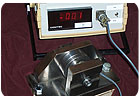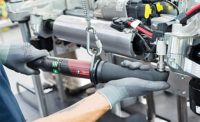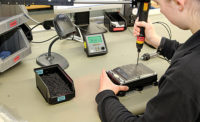Some suppliers tout the ergonomic benefits of their tools; others emphasize the accuracy of their products. This independent study looks at the trade-offs.

When choosing a power tool to install threaded fasteners, engineers have never had so many options. Clutch, pulse and impact tools are now available in pneumatic, electric and battery-powered versions. Each tool offers a different set of performance characteristics, but sorting out their relative benefits isn’t easy. Comparative information on each tool is just not available. We decided to remedy that situation by conducting an independent comparative study of various power tools.
Before getting into the details of the study, however, let’s look at the two basic requirements for power tools. First, every power tool must be ergonomic. Many attributes make a tool ergonomic, including low torque reaction, quiet operation, and the ability to operate in confined quarters. Second, every power tool must be accurate. If an operator can safely use a tool for hours, but none of the fasteners are tightened correctly, what have you gained?
To see how these two requirements play out in tool selection, consider how lug nuts are tightened. Lug nuts are typically tightened to 100 ft-lb. To apply that amount of torque with a manual wrench, an operator must exert approximately 70 pounds of force on the handle of the tool. In addition, the wheel must be locked so it doesn’t turn. Exerting that much force is fatiguing, and locking the wheel is time-consuming. As a result, lug nuts are rarely tightening manually.
The same operation can be done with much less effort using an impact wrench. Little manual force is required, and the wheel doesn’t have to be locked. Given the savings in both time and effort, it’s not surprising that impact wrenches are the predominant tool for installing wheels. The ergonomic benefits are huge.
But are the nuts tightened correctly? Torque accuracy with impact wrenches depends on operator skill, since these tools typically do not have torque adjustment or an automatic shut-off. Experience suggests that overtightening is common, and torque values may exceed 100 ft-lb by 50 percent to 100 percent. This is not surprising, since the torque capacity of the typical 0.5-inch impact tool exceeds 300 ft-lb.
This example shows a stark choice between ergonomics and torque accuracy: between the low torque reaction of an impact tool and the high accuracy of a torque wrench.
On the assembly line, the debate over fastening tools has tilted in favor of torque accuracy and away from ergonomics. The growing use of transducerized DC electric tools and precision shut-off nutrunners reflect this trend. These geared tools tighten continuously and have clutches or transducers that closely measure torque.
Development of these tools was stimulated in large part by Ford Motor Co. (Dearborn, MI). In the 1970s, the automaker began seeking tools that would deliver the same torque irrespective of the fastener they were used on. Ford’s requirement also prompted the development of special test equipment that later became the basis for the international standard ISO 5393, “Rotary Tools for Threaded Fasteners-Performance Test Method.” This equipment simulates tightening operations by having the tool twist a torsion bar until the shut-off torque is reached. Using a torsion bar eliminates friction and other variables inherent in tightening fasteners. During the test, the tool is mounted in a rigid fixture, even if it is normally handheld.
The torsion bar test method does not handle all types of tool. ISO 5393 only covers tools that apply torque continuously. It does not apply to impact and pulse tools, which advance fasteners in discontinuous increments. That’s because the torque applied by these tools cannot be measured using conventional instrumentation. These tools are also called “discrete energy” or “discontinuous” tools, because torque is applied to the fastener from individual blows or pulses, rather than the continuous motion of a motor and gear train.
Because there is no equivalent to ISO 5393 for discontinuous tools, little data exists on the tightening accuracy or consistency of impact and pulse tools.

The author’s test joint consists of a high-strength aircraft bolt, hardened washers and a nut. Clamp load was measured by a load cell inserted in the joint. Torque was measured with an electronic torque wrench. Photo courtesy Impact Fastening LLC
Impact and Pulse Tools
Despite the absence of performance standards, the popularity of pulse tools is growing. Their main attraction is that they produce little torque reaction. They also have a good combination of speed and torque. This makes them ideal for manual assembly, enabling operators to work the tool with one hand while positioning components with the other hand.All pulse tools have some form of direct or indirect torque control. The simplest is a stall torque adjustment in the pulse mechanism that limits torque output. Another option is a shut-off mechanism that stops the tool when the set torque is reached. A third type is equipped with a transducer and electronic controller. When the set torque is reached, the tool is shut off by a valve. This type of pulse tool can be used for precision fastening.
The widespread use of pulse tools in assembly suggests that engineers are have found a workable balance between ergonomics and torque accuracy. However, the same cannot be said of impact tools. Few torque-controlled models are available. Cordless impact tools have recently been introduced, but most lack adjustment or shut-off mechanisms.
Tools Get Put to the Test
|
Tool Type |
Power Source |
Shut-off Method |
Maximum Torque Rating |
|---|---|---|---|
| Torque wrench | Manual | Click mechanism | 200 newton-meters |
| Adjustable shut-off nutrunner | Pneumatic | Clutch | 55 newton-meters |
| Cordless impact tool with control | Battery | Electronic | 160 newton-meters |
| Transducerized pulse tool | Pneumatic | Valve | 100 newton-meters |
| Shut-off pulse tool | Pneumatic | Mechanical | 45 newton-meters |
| Stall pulse tool | Pneumatic | 90 newton-meters |
The author tested six types of power tool to assess their accuracy and ergonomic performance.

With one exception, the tools tested in this study were commercially available models from established manufacturers. The exception was this prototype model of a torque-controlled cordless impact wrench. According to the test results, the tool provided torque shut-off performance that was comparable with the best pulse tools. Photo courtesy Impact Fastening LLC
The Test Approach
To obtain data on the comparative accuracy of fastening tools, we tested six different models: a manual torque wrench; a pneumatic nutrunner with a shut-off clutch; a transducerized pneumatic pulse tool; a pneumatic pulse tool with a shut-off clutch; a pneumatic pulse tool with a stall clutch; and a prototype torque-controlled cordless impact wrench.The adjustable shut-off nutrunner was included because it is representative of tools that are commonly certified through the ISO 5393 process. The three pulse tools were included to determine if there was a significant performance difference between the different types. The stall-type pulse tool was the only one that did not have an automatic shut-off, so it was run to its perceived stall point. The cordless impact tool was included to see how it compared against established tools. Because the tools had different maximum torques, each was set at about 80 percent of capacity.
Before we could put the tools through their paces, we needed a test rig. To provide meaningful data, the rig had to be a bolted joint that could be tightened by all tool types. It had to provide consistent, repeatable results over time, and different joint characteristics, such as stiffness, had to be adjustable.
Such a rig was designed and manufactured by P&T Precision Engineering Ltd. (Naas, Ireland). For consistency and durability, the joint consists of a high-strength aircraft bolt, hardened washers and a nut.
For our test, each tool was run 20 times on a soft joint and 20 times on a medium joint, and the clamp load and torque for each rundown were recorded. The clamp load was measured by a load cell inserted in the joint. Torque was measured with an electronic torque wrench using the break-forward method, or the torque at which the clamp load increases by a small increment. There is some inherent scatter in this measurement. For example, the reading can be affected by varying friction in the joint from test to test and also by variations in how much the joint is tightened further during measurement. This is why the manual torque wrench, which produces almost no variation in applied torque, was included in the program: to check the accuracy of our measurement process.
We then calculated the mean and standard deviation for each set of measurements. Capability, defined as six standard deviations as a percent of the mean torque, was calculated for each joint and for the combined joints. This is essentially the evaluation procedure described in ISO 5393.
The most accurate tool was the manual torque wrench, with a capability of 5 percent on the soft joint, 9 percent on the medium joint, and 8 percent for both. This is very accurate and indicates that our test approach of measuring residual torque was reliable. We calculated that a random error of only ±1 newton-meter would produce a capability of 6 percent, and an error of only ±0.5 newton-meter would produce a capability of 4 percent. Our measurements were made in increments of 1 newton-meter.
The next best tool was the adjustable shut-off nutrunner. On individual joints, the capability was about 25 percent. This is a much higher scatter than this tool would have produced on the ISO 5393 test rig, on which it yields a capability of approximately 10 percent. The additional scatter is probably because the tool is handheld instead of fixtured and because it’s tested on a fastener instead of torsion bars. Whatever the reason, the results indicate that tool capability as measured by ISO 5393 is significantly better than can be achieved under practical fastening conditions.
The cordless impact tool and the transducerized pulse tool produced similar capabilities. The capability of both tools was in the 20 percent range on the medium joint. Surprisingly, the pulse and impact tools were equal to or better than the shut-off nutrunner on both the soft and medium joints. However, looking at the combined data for both joints, the nutrunner was significantly better than either tool. The nutrunner had a combined capability of 33 percent, compared with 46 percent for the cordless tool and 48 percent for the transducerized pulse tool.
This difference in capability between the nutrunner and the pulse and impact tools is due to how the tools respond to variations in joint stiffness. Going from the medium to the soft joint dropped their mean torque values by approximately 25 percent, while the nutrunner dropped only 8 percent. That means that the torque output of the tools, even with the transducerized tool, depends significantly on the joint type.
Test Results for Medium Joint
|
Tool Type |
Mean Torque |
Torque Range |
Torque Standard Deviation |
Percent Capability (Six Sigma Scatter) |
|---|---|---|---|---|
| Torque wrench | 82.7 | 81 to 84 | 1.2 | 9% |
| Adjustable shut-off nutrunner | 49.8 | 45 to 55 | 2.1 | 25% |
| Cordless impact tool with control | 77.9 | 74 to 83 | 2.4 | 19% |
| Transducerized pulse tool | 79.1 | 75 to 84 | 2.7 | 20% |
| Shut-off pulse tool | 40.2 | 36 to 43 | 2.3 | 34% |
| Stall pulse tool | 84.7 | 79 to 94 | 6.1 | 43% |
This table shows the results of testing the tools on a medium joint. Torque values are in newton-meters. The capability value represents total variation in applied torque. If expressed as a ± value, it should be cut in half.
Capabilities vs. Needs
How should these capability results be judged? The only practical comparison is against the torque tolerance requirements for bolted joints. These requirements are commonly classified into three categories: Class 1, Class 2 and Class 3. These classes cover all but the most highly stressed bolts, such as connecting rods.The torque capability of most of the tools in our study is sufficiently accurate to meet the tolerances of all three classes. This is particularly true if the tool is used on just one joint. In many production applications, this is not a problem. Tools are set for a particular assembly and torque value, and are then used only for that application. Under these circumstances, pulse tools perform with comparable accuracy to the shut-off nutrunner and other geared clutch tools.
However, if the tools are used without adjustment on different joints, the picture changes substantially. The combined joint variability of the pulse and impact tools increases to the point that they will meet the requirements only for a lower class of fastening.
It is clear that the superior performance of the manual wrench and the adjustable clutch nutrunner arises from their ability to work accurately on different joints. However, it is also clear that the pulse and controlled impact tools can produce acceptable torque accuracy, even on different joints, provided the tightening tolerances are less stringent. Engineers can often account for that when designing the joint and specifying the fastener.
For more information on tool testing, joint design and other fastening issues, call Impact Fastening at 215-345-4470.
Test Results for Soft Joint
|
Tool Type |
Mean Torque |
Torque Range |
Torque Standard Deviation |
Percent Capability (Six Sigma Scatter) |
|---|---|---|---|---|
| Torque wrench | 81.7 | 81 to 83 | 0.7 | 5% |
| Adjustable shut-off nutrunner | 45.8 | 42 to 49 | 1.8 | 24% |
| Cordless impact tool with control | 56.3 | 55 to 58 | 1 | 11% |
| Transducerized pulse tool | 58.1 | 56 to 62 | 1.6 | 17% |
| Shut-off pulse tool | 28.5 | 26 to 32 | 1.5 | 32% |
| Stall pulse tool | 69.2 | 64 to 78 | 4.4 | 38% |
This table shows the results of testing the tools on a soft joint. Torque values are in newton-meters. The capability value represents total variation in applied torque. If expressed as a ± value, it should be cut in half.

